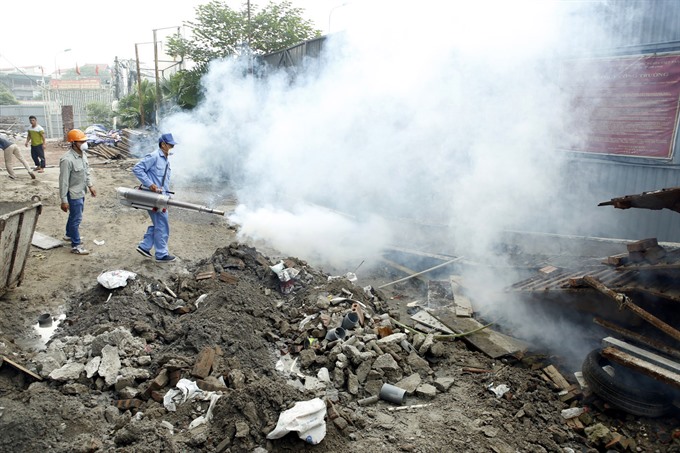 Society
Society

The spread of dengue fever in Việt Nam is showing signs of slowing down. There are fewer new cases and no deaths reported in the last two weeks.
 |
| Health workers spray insecticide to kill mosquitos at a construction site in Hà Nội’s Tây Hồ District. — VNA/VNS Photo Dương Ngọc |
HÀ NỘI — The spread of dengue fever in Việt Nam is showing signs of slowing down. There are fewer new cases and no deaths reported in the last two weeks, reported the health ministry.
Trần Đắc Phu, director of the Preventive Medicine Department under the Ministry of Health, said at a meeting on disease prevention and control on Thursday that during the week from August 21 to August 27, 6,292 dengue fever cases were reported, down 11.4 per cent over the previous week. No deaths have been recorded since August 14.
However, he said that the rate remained high as this time of the year was usually a peak time for dengue fever in Việt Nam.
According to the Preventive Medicine Department, since the beginning of this year, 108,925 dengue fever cases have been reported, with 26 deaths.
Over 91,600 cases were hospitalised, a rise of 43.5 per cent in the number of cases and seven deaths higher than the same period last year.
The virus is mainly found in the southern region, which accounted for 51.2 per cent of dengue patients.The increased number of patients stretched hospital resources, including longer working hours. It is also common to see two or three patients share a bed. This year, dengue fever spread widely in northern provinces, particularly in Hà Nội – the hardest hit with the highest number of dengue fever cases.
From January 1 to August 28, 22,296 people caught the virus, with seven deaths, mostly in Hoàng Mai, Đống Đa, Hai Bà Trưng and Thanh Xuân districts.
The health ministry attributed the rise of dengue outbreaks to higher temperatures, more rain and rapid urbanisation that promote the breeding of virus-carrying mosquitoes.
This year, summer arrived earlier than previous years, causing higher average temperature in most areas. Many residents store water in uncovered containers where mosquitoes lay eggs.
Health experts said that eggs with the dengue virus could stay in water tanks for up to six months and develop into larvae.
Hà Nội’s health department reported 2,900 dengue fever patients last week, 18 per cent lower than that of the previous week.
Last week is the second week in a row the city saw a reduction in the number of dengue patients.
By early this week, communes, wards and towns throughout the city established over 26,000 teams, meaning a total of 63,000 people killing mosquito larvae and about 4,640 teams, or 9,340 people, surveying disease prevention.
However, the department admitted that 30 per cent of the teams worked ineffectively and mosquito larvae were detected at 20 per cent of surveyed houses
Trần Như Dương, vice head of National Institute of Hygiene and Epidemiology said that weather in Hà Nội at this time was favourable for the mosquito’s reproduction so conditions could possibly get worse.
For example, in Thịnh Liệt Ward of Hoàng Mai district, on average, 0.23 mosquitos were found at every house before insecticide was sprayed. One day after spraying, the rate was zero but seven days after spraying, the rate increased to 0.05.
Nguyễn Văn Kính, Director of the Central Hospital for Tropical Diseases, said the number of people coming to the hospital for dengue fever tests had reduced by half to about 350 per day.
However, Phu from the Preventive Medicine Department warned that the dengue fever outbreak would continue developing with a high risk remaining in many localities. He said that the Ministry of Health would keep a close eye on Hà Nội, HCM City, some (Hồng) Red River areas, central coastal and Central Highlands provinces to ensure a timely response. — VNS




